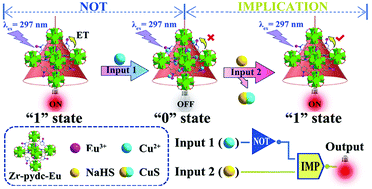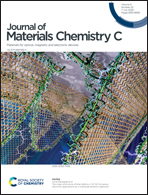A smart luminescent metal–organic framework-based logic system for simultaneous analysis of copper ions and hydrogen sulfide†
Abstract
Simultaneous detection of multiple targets is in imperative demand but is challenging for analysis technology. In this study, a novel, multi-input luminescent logic system based on a nanoscale Zr(IV)/Eu(III) metal–organic framework (Zr-pydc-Eu) is designed for simultaneous identification and quantification of copper ions and hydrogen sulfide, which are considered to be not only toxic species in the environment but also associated with various physiological and pathological processes in the human body. In the MOF-based logic gate, pyridine-2,5-dicarboxylic acid (pydc) behaves as both the energy donor and the metal-chelating site, the photoactive Eu3+ ions function as the luminescence signal reporter/output, and the target analytes (Cu2+ and H2S) serve as energy modulators/inputs. By using the specific Cu2+ ions as a single input among various metal ions, the NOT logic operation is realized in Zr-pydc-Eu with the output switching from “1” to “0”. With the sequentially restored output from “0” to “1” by H2S input over the biologically relevant species, the IMPLICATION logic gate is implemented. Such features enable this Zr-pydc-Eu logic system to be an effective and smart platform for analyzing both Cu2+ and H2S with a low detection limit (10−8 M) and a real-time response (<2 min), presenting significant potentials for multiplex analysis application in human health monitoring.



 Please wait while we load your content...
Please wait while we load your content...